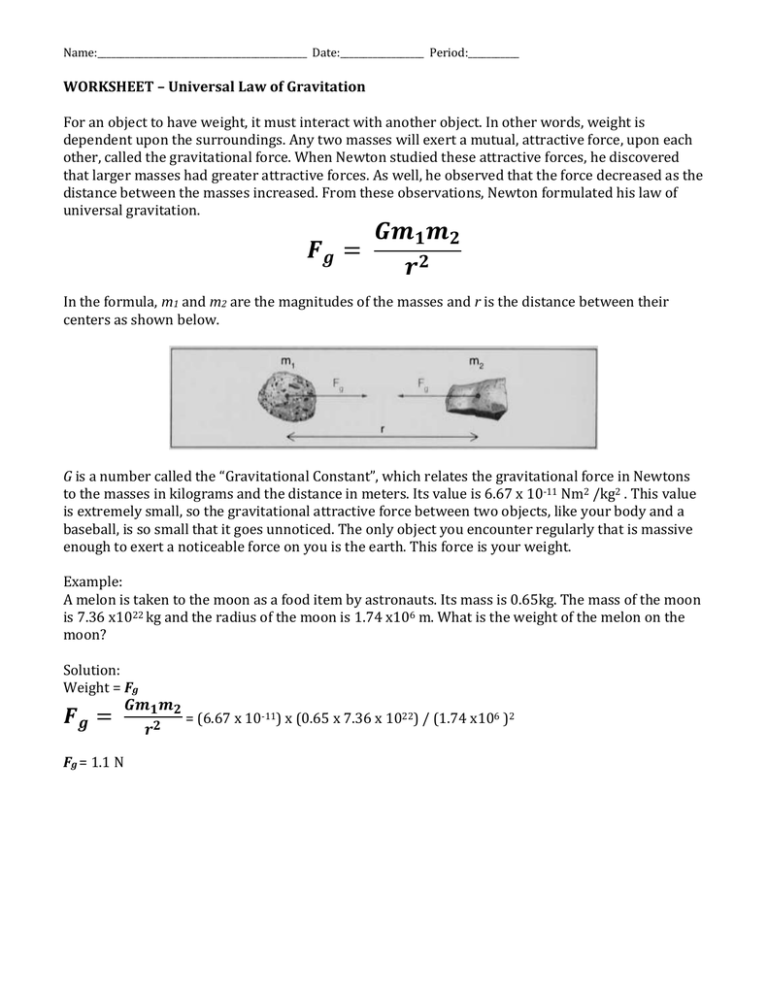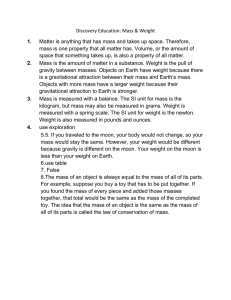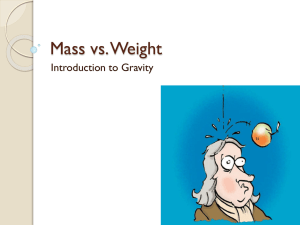Gravitation WS
advertisement

Name:_____________________________________________ Date:__________________ Period:___________ WORKSHEET – Universal Law of Gravitation For an object to have weight, it must interact with another object. In other words, weight is dependent upon the surroundings. Any two masses will exert a mutual, attractive force, upon each other, called the gravitational force. When Newton studied these attractive forces, he discovered that larger masses had greater attractive forces. As well, he observed that the force decreased as the distance between the masses increased. From these observations, Newton formulated his law of universal gravitation. 𝑮𝒎𝟏 𝒎𝟐 𝑭𝒈 = 𝒓𝟐 In the formula, m1 and m2 are the magnitudes of the masses and r is the distance between their centers as shown below. G is a number called the “Gravitational Constant”, which relates the gravitational force in Newtons to the masses in kilograms and the distance in meters. Its value is 6.67 x 10-11 Nm2 /kg2 . This value is extremely small, so the gravitational attractive force between two objects, like your body and a baseball, is so small that it goes unnoticed. The only object you encounter regularly that is massive enough to exert a noticeable force on you is the earth. This force is your weight. Example: A melon is taken to the moon as a food item by astronauts. Its mass is 0.65kg. The mass of the moon is 7.36 x1022 kg and the radius of the moon is 1.74 x106 m. What is the weight of the melon on the moon? Solution: Weight = Fg 𝑭𝒈 = 𝑮𝒎𝟏 𝒎𝟐 Fg = 1.1 N 𝒓𝟐 = (6.67 x 10-11) x (0.65 x 7.36 x 1022) / (1.74 x106 )2 Mass of: Earth Jupiter Mars Mercury The Moon Neptune Saturn The Sun Uranus Venus Radius of: 5.98 x 1024 kg 1.91 x 1027 kg 6.43 x 1023 kg 3.32 x 1023 kg 7.36 x 1022 kg 1.03 x 1026 kg 5.68 x 1026 kg 1.99 x 1030 kg 8.74 x 1025 kg 4.89 x 1024 kg Earth Jupiter Mars Mercury Neptune The Sun Uranus Venus 𝑭𝒈 = distance from Earth to the sun = 1.50 x 1011 m distance from Earth to the moon = 3.84 x 108 m 1 pound = 4.545 newtons 6.38 x 106 m 7.14 x 107 m 3.40 x 106 m 2.44 x 106 m 2.43 x 107 m 7.00 x 108 m 2.61 x 107 m 6.05 x 106 m 𝑮𝒎𝟏 𝒎𝟐 𝒓𝟐 G = 6.67 x 10-11 Nm2/kg2 distance from Saturn to the sun = 1.43 x 1012 m 1 meter = 3.28 feet 1 mile = 1609 meters 1) How much would a 70.0-kg person weigh on Mercury? 2) How much would your 20.0-kg dog weigh on Neptune? 3) If Pete (mass = 90.0 kg) weighs himself and finds that he weighs 30.0 pounds, how far away from the surface of the earth is he? 4) Captain Kirk (80.0 kg) beams down to a planet that is the same size as Uranus and finds that he weighs 1250 N. What is the mass of that planet? 5) Which is greater, the force exerted by Saturn on the sun, or the force exerted by the earth on the Sun? How much greater? 6) A distance of 2.00 mm separates two objects of equal mass. If the gravitational force between them is 0.0104 N, find the mass of each object. 7) Calculate the gravitational field strength (g) on the surface of Jupiter. 8) If the gravitational field strength at the top of Mount Everest is 9.772 N/kg, approximately how tall (in feet) is the mountain? 9) If you dropped a ball while standing on the surface of Mars, at what rate would it accelerate toward the ground? 10) A space probe lands on the surface of a spherical asteroid 250 miles in diameter and measures the strength of its gravitational field at that point to be 4.95 x 10-11 N/kg. What is the mass of the asteroid? 11) Determine the force the sun exerts on an object with a mass of 80.0 kg if that object is on the earth. What is the force exerted by the moon on the same object? What is the force the earth exerts on it? 12) If a person weighs 882 N on the surface of the earth, at what altitude above the earth’s surface must they be for their weight to drop to 800 N? 13) If a 50.0-kg mass weighs 554 N on the planet Saturn, calculate Saturn’s radius. 14) Calculate the distance between the center of the earth and the center of the moon at which the gravitational force exerted by the earth on an object is equal in magnitude to the force exerted by the moon on the object.







